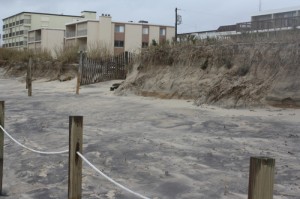
OCEAN CITY – The sea wall on the Boardwalk, along with other storm protection measures, did better in Ocean City than the U.S. Army Corps of Engineers’ expected.
On Tuesday Baltimore District commander Col. Trey Jordan visited Ocean City to conduct a preliminary assessment of the Atlantic Coast of Maryland Shoreline Protection Project, or beach replenishment, following Hurricane Sandy.
“The Corp of Engineers is interested in public safety and all of our projects like this are designed to protect the public and I am very happy that it designed better than designed,” Jordan said.
According to the U.S Army Corps of Engineers, the Atlantic Coast of Maryland Hurricane Shoreline Protection Project was initiated from 1990-1992. The project costs are shared 53 percent federal, 47 percent non-federal.
“It started when a non-federal organization, such as the Town of Ocean City, comes forward and says we would like to partner with the federal government to help do what we need to do and in this case it was to protect the city from future storms,” Jordan said.
In working with Ocean City, the U.S Army Corp of Engineers created a design and received congressional approval.
The project provides a steel sheetpile bulkhead, or the sea wall, along the Boardwalk for 1.4 miles from 4th Street to 27th street, the placement of 3.6 million cubic yards of sand along the Ocean City coastline to widen and raise the beach profile for 8.3 miles from 3rd Street, north to the Maryland-Delaware line with an additional 0.3-mile transition into Delaware, and the construction of a vegetated sand dune for 6.9 miles from 27th Street, north to just beyond the state line.
It also provides for periodic beach re-nourishment and monitoring over the 50-year project life, to end in 2044. On average, 800,000 cubic yards of sand are required to re-nourish the beaches every four years. The last re-nourishment was completed in fall 2011, with the next scheduled for 2014. Maintaining the re-nourishment cycles for the remaining life of the project will require 10-12 million cubic yards of sand.
On Tuesday, Jordan inspected the project between 4th and 27th street to view the seawall and the vegetated sand dunes.
“I am the commander so I move at the sound of the guns and my initial assessment is that this project performed better than expected,” Col. Jordan said.
On Wednesday, a U.S Army Corps of Engineers specialized team was scheduled to come into town to complete calculations on the damage done to complete a formal report.
“I am certainly not seeing any kind of breaches that I have seen in the past in the barrier islands, no major damage to the infrastructure, so I don’t see any immediate need to come back out here,” Jordan said from his initial assessment.
Jordan said at first glance some may think the project didn’t perform but it actually did exactly what it was designed to do.
“It takes the damage from the storm, the energy from the storm, and dissipates it,” he said. “So the question really is what we need to do to bring the beach back to the standards in which we designed it. So sometime between now and 2014, which was originally when we were scheduled to come and replenish the beach with sand anyway, we will be out here.”
Taking a look back in time before the project began, Jordan recalled when Ocean City’s Boardwalk needed to be replaced every two to 10 years but once the sea wall was constructed sections of the Boardwalk are now lasting 15-20 years.
“You can see the difference that the Shore Protection Project makes,” he said. “From what I have seen from the shots of the ocean and the wave action [during Hurricane Sandy], I couldn’t help but believe it would have washed up further than it did.”
